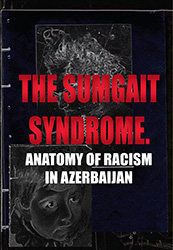The Sumgait Syndrome. Anatomy of Racism in Azerbaijan
“The Sumgait Syndrome. Anatomy of Racism in Azerbaijan”

MIA Publishers, 2012
By NGO “Against Xenophobia and Violence”
Sumgait is 26 kilometres from Azerbaijan’s capital, Baku, and was home to some 18,000 Armenians in 1988. On 26 and 27 February 1988, demonstrations were organised in Sumgait under the slogan
“Death to Armenians!” What took place on the streets of Azerbaijan during the following three days has been referred to ever since with the horrific name of “Sumgait”.
The massacre of Armenians in Sumgait, February 27–29, were merely a continuation of the Azerbaijani authorities’ unswerving policy of racism towards Armenians and ethnic cleansing of the Armenian population, with unpunished killings and deportations.
[New York Times] Two Steps Backwards in the Caucasus
By PETER RUTLAND
Published: September 10, 2012
In recent days there have been two symbolic events that run the danger of igniting hostilities in an already tense neighborhood of the Caucasus.
On Aug. 31 a former Azerbaijan Army lieutenant, Ramil Safarov, flew back to Baku after serving eight years in a Budapest jail for killing Gurgen Margarian in 2004. The victim, an Armenian officer, had been a fellow participant in a NATO Partnership for Peace exercise. Safarov hacked him to death in his sleep with an ax.
The Hungarian government transferred the prisoner to Azerbaijan on the understanding that he would serve out the rest of his life sentence in his home country. But immediately upon his arrival in Baku, Lieutenant Safarov was pardoned by President Ilham Aliyev, restored to military duties, promoted to major, given an apartment and awarded back pay for his time in prison. These actions drew universal condemnation from Washington, Moscow and European governments.
read moreLevon CHOBAJIAN “The Making of Nagorno-Karabagh: From Secession to Republic”, 2001
“The Making of Nagorno-Karabagh: From Secession to Republic”
Palgrave Publishers Ltd 2001
Edited by: Levon CHOBAJIAN
The first major territorial struggle in the late Soviet period involved Nagorno-Karabagh, an Armenian-inhabited territory that had been assigned to the Azerbaijan Soviet Socialist Republic in the early 1920s. Armenian protests calling for reunification with Armenia in 1988 led to Azerbaijani pogroms against Armenians and later to armed conflict that claimed over 20,000 lives. The struggle remains unresolved. A distinguished group of historians and social scientists analyze the Karabagh struggle in this unique volume, which covers one of the world’s strategic, oil-rich regions.
read moreCaroline Cox and John Eibner “Ethnic Cleansing in Progress: War in Nagorno Karabakh”, 1993
Ethnic Cleansing in Progress: War in Nagorno Karabakh
Institute for Religious Minorities in Islamic World (April 1993)
By Caroline COX and John EIBNER
Contents
Preface
Introduction
Basic Facts
A Conflict of Civilizations
The Genocide
The Pincers of Pan-Turkism
Soviet Rule
State Independence Declaration of the Nagorno Karabagh Republic
Considering the intrinsic right of nations to self-determination and being guided by the free will of the people of the Nagorno Karabagh Republic expressed at the Republican referendum on December 10, 1991;
Realizing responsibility for the destiny of the historical Motherland;
Being committed to the principles of the September 2, 1991 Declaration On Proclamation of the Nagorno Karabagh Republic;
read moreDeclaration on Proclamation of the Nagorno Karabakh Republic
Joint session of the Nagorno Karabakh Oblast and Shahoumian regional councils of people’s deputies with the participation of deputies of councils of all levels
Expressing the will of people, in fact, fixed by a referendum and in the decisions of the NKAO and Shahoumian regional authorities in 1988-1991, its strive for freedom, independence, equality and good neighbourly relations;
ascertaining proclamation by the Azerbaijani Republic of the “restoration of 1918-1920 state independence”;
read moreS.RES.128 — Condemning violence in Armenia. (Agreed to Senate – ATS)
SRES 128 ATS
102d CONGRESS
1st Session
S. RES. 128
Condemning violence in Armenia.
IN THE SENATE OF THE UNITED STATES
May 17 (legislative day, APRIL 25), 1991
Mr. LEVIN (for himself, Mr. DOLE, Mr. PRESSLER, Mr. PELL, Mr. SEYMOUR, Mr. SIMON, Mr. KASTEN, Mr. KENNEDY, Mr. SPECTER, Mr. SARBANES, Mr. WARNER, Mr. DECONCINI, Mr. RIEGLE, Mr. BRADLEY, and Mr. HELMS) submitted the following resolution; which was considered and agreed to
RESOLUTION
Condemning violence in Armenia.
read more[European Parliament B3-0473/91] Resolution on the blockade of Armenia and the human rights situation there
The European Parliament,
- whereas the inhabitants of Nagorno-Karabakh have been calling on the central authorities of the USSR for a just solution to the question of their region since February 1988,
- whereas, as a consequence of the decision by the Supreme Soviet of the USSR on 28 November 1989, the state of emergency imposed by the military governor of this region has entailed the removal of all the legitimate authorities and continual violations of human rights, such as arbitrary arrests, censorship and deportations,
- whereas the referendum of 17 March 1991 — which Armenia has decided to boycott — will not provide a solution to the Karabakh problem, which calls for a special referendum of a different kind enabling the national groups in this region to exercise their right to self-determination;
- whereas the blockade afflicting Armenia and Nagorno-Karabakh, which is sometimes suspended only to be subsequently re-imposed more severely, is raising the tension between Azerbaijan and Armenia to breaking point,
- whereas the 300 000 Armenians who have fled from Azerbaijan (Baku and Sumgait massacres) to Armenia are in a state of complete destitution and require urgent aid,
- whereas the shortage of energy, and in particular gas, currently affecting Armenia as a result of the blockade has given rise to serious problems in that republic, including the closure of factories, unemployment and paralysis of the transport system,
- whereas as a result of the earthquake and the massacres of Armenians in Azerbaijan more than 500 000 people are now faced with extreme hardship, unable to obtain heating at a time when the temperatures in the region could be falling to 25° below zero,










